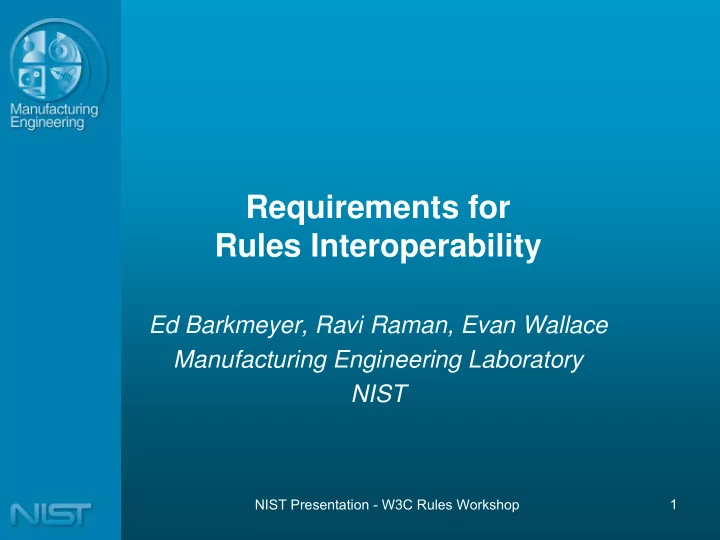

Requirements for Rules Interoperability Ed Barkmeyer, Ravi Raman, Evan Wallace Manufacturing Engineering Laboratory NIST NIST Presentation - W3C Rules Workshop 1
General Architecture • Multiple ontology and rules languages • Reference concept set(s) (meta-models) – first-order, temporal, deontic, SCLP, data logic – reasoner class/style labels (DLs, SCLP, etc.) • Rigorous foundation – Multiple incompatible foundations? • Reference mapping from each language to (a set of) meta-concepts • Standard exchange form – multiple standard forms? NIST Presentation - W3C Rules Workshop 2
Discipline • Flyswatter principle: – don’t use a feature that requires a power reasoner just because it is easier or clearer – don’t require circumlocutions: automate transforms to tractable structures • External ↔ internal transforms – make assumptions clear to author – don’t lose or add information – results must make sense in external form • Logic safety – develop discipline for testing and verification of ontologies and rulesets – need to be able to exchange proofs (PML?) – don’t make users read traces NIST Presentation - W3C Rules Workshop 3
Common Rules Needs • Converting measurements in different units – real arithmetic, exponents: mi/gal → litre/100km • Resolving structural differences in representing the same information – organization of the elements of person-names – time intervals: (begin, end) vs. (begin, duration) • XML Schema "restriction" – limit instances of class permitted in a given usage – limit properties permitted in a given usage – limit occurrences in a given usage • Reasoning about region containment, intersection – both geometric and geographic NIST Presentation - W3C Rules Workshop 4
Rules in (Engineering) Models • variables to support co-reference – instances of a class with the same hasLocation value – recognize siblings by common hasParent value • partOf properties – parts derive properties from whole – assemblies rollup properties of parts: sets, sums • arithmetic constraints on multiple properties – car.AC.weight + car.engine.weight ≤ 1000 kg • implication between two properties for a given class – if car has towing package, then car has heavy duty transmission • exclusion between two properties for a given class – Model X cannot have both an automatic transmission and a supercharged engine NIST Presentation - W3C Rules Workshop 5
Kinds of Rules • Information model rules – describe the “business objects” – define validity of the information base (“consistent state”) – useful for inferencing • Business logic and workflow rules – specify requirements for the behaviors of agents – guide choreography of business applications • Semantic Webservice specifications – defines agent behavior (pre-condition/post-condition) – support dynamic integration, interoperability of software, – enables reliability of systems • Need integration/interoperation of all kinds of rules NIST Presentation - W3C Rules Workshop 6
Operating Rules Environment • External agents – webservices and workflows – rule activates function outside the engine – agent may be automaton or human • Concept of time – relative: true now, later, before X, after X – rule firing must be synchronized with events • Complex information space – current info from multiple sources – rules engine and agents maintain consistency NIST Presentation - W3C Rules Workshop 7
Rules Engine Requirements • Decision structure language • External events represented in the language • External events and information communicated to engine knowledge base • External agent invocation (protocol support) – termination implies post-condition – finite resources: delays, queues • Need standard meta-rules language – meta-rules may involve external events – meta-rules to prevent agent interference NIST Presentation - W3C Rules Workshop 8
Questions NIST Presentation - W3C Rules Workshop 9
Recommend
More recommend